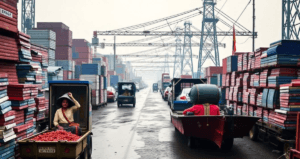Trade Restrictions: 7 Shocking Barriers Hurting Indian Exports
India is setting up a platform to track trade restrictions imposed by various countries, with the EU, US, and China being the top sources of concern. Exporters have flagged issues like strict labeling and safety regulations for toys, increased compliance costs in the textile sector, and stringent environmental and consumer safety norms. The diamond industry is seeking exemptions from mining origin requirements due to G7 sanctions on Russia, which could impact $8 billion worth of exports. Gold and silver traders are also facing hurdles with BIS certification recognition.
In agriculture, despite meeting compliance standards, Indian grape exports remain restricted by the US, prompting calls for more certification agencies. Additionally, exporters are struggling with high registration fees and tough FDA regulations. Unlike the USTR, India will not release an annual report but will systematically highlight these issues in trade talks. Some Indian regulations, such as restrictions on dairy imports based on religious beliefs and security concerns, have also been defended by officials.

Trade Restrictions: 7 Shocking Barriers Hurting Indian Exports
The Indian government is developing a digital platform to identify and address international trade barriers affecting domestic industries. This initiative responds to feedback from businesses struggling with complex regulations in key export markets. Early reports highlight the European Union (EU), the United States (U.S.), and China as the top sources of these challenges, with 24, 22, and 20 complaints logged against them, respectively. Indian officials have already begun discussions with U.S. counterparts to resolve some of these issues.
Key Challenges Across Industries
Toys and Textiles
Indian toy exporters face hurdles due to stringent labeling and safety standards in foreign markets, particularly in the EU and U.S. While these regulations aim to protect consumers, they significantly raise compliance costs for manufacturers. Similarly, textile exporters struggle with environmental sustainability and product safety norms. Meeting these requirements often requires costly upgrades to production processes and certifications, putting pressure on profit margins.
Diamonds and Precious Metals
The diamond industry is calling for exemptions from strict origin-tracing rules linked to G7 sanctions on Russian diamonds. With $8 billion in annual exports at stake, traders argue that many Indian-processed diamonds originate from Russia, making full compliance impractical. Meanwhile, gold and silver exporters face challenges due to the limited recognition of India’s Bureau of Indian Standards (BIS) certification in certain markets, leading to delays and restricted access.
Agriculture and Organic Exports
India’s agricultural sector, particularly grape exporters, continues to face trade barriers. Despite fulfilling U.S. compliance requirements, shipments are frequently delayed or rejected. The Agricultural and Processed Food Products Export Development Authority (APEDA) has urged the U.S. to expand its list of approved Indian organic certification agencies until a bilateral agreement is finalized. This would provide organic farmers with better market access and reduce bottlenecks caused by limited certification recognition.
Regulatory and Cost Hurdles
High registration fees and stringent U.S. Food and Drug Administration (FDA) regulations have drawn criticism from Indian exporters. Many argue that these costs are excessive, especially for small and medium enterprises. Unlike the U.S., which publishes an annual report on global trade barriers through its Trade Representative (USTR), India has chosen to address these concerns directly through trade negotiations rather than formal public reports. Officials emphasize the need for a structured approach to highlight these challenges during discussions with partner nations.
Defending Domestic Policies
Indian authorities have responded to international criticism of their own trade regulations, citing cultural, religious, and security factors. For example, dairy import restrictions mandate that cattle should not be fed animal-based feed, aligning with cultural sentiments in a predominantly vegetarian-friendly market. Additionally, certain import restrictions are tied to national security concerns, such as protecting sensitive industries or preventing unfair trade practices.
Balancing Compliance and Competitiveness
As trade restrictions continue to evolve, Indian exporters are urging policymakers to ensure that international standards do not become disguised trade barriers. While businesses respect the need for compliance, sudden changes in safety or environmental regulations—without adequate transition periods—create uncertainty and financial strain. This is particularly evident in industries like textiles and diamonds, where adapting to new norms requires time and investment.
The Path Forward
The government’s new platform aims to consolidate real-time data on trade barriers, allowing for quicker responses and more targeted negotiations. By prioritizing exporter concerns, India seeks to foster fairer trade relationships. However, balancing compliance with global standards while maintaining competitiveness remains a challenge.
India continues to engage in diplomatic efforts to ease trade restrictions. Discussions with the U.S. focus on securing market access and achieving mutual recognition of certifications to reduce redundant testing and compliance costs. Similarly, negotiations with the EU aim to align sustainability requirements with India’s economic realities, particularly by introducing phased timelines for small businesses to implement eco-friendly practices.
Conclusion
As global trade becomes increasingly complex, India’s proactive approach demonstrates its commitment to protecting domestic industries. By addressing external trade barriers and defending domestic policies rooted in cultural and security considerations, India aims to strike a balance between compliance and economic growth. The success of these efforts will depend on diplomatic collaboration and the ability to navigate evolving international standards while safeguarding national interests.
You must be logged in to post a comment.